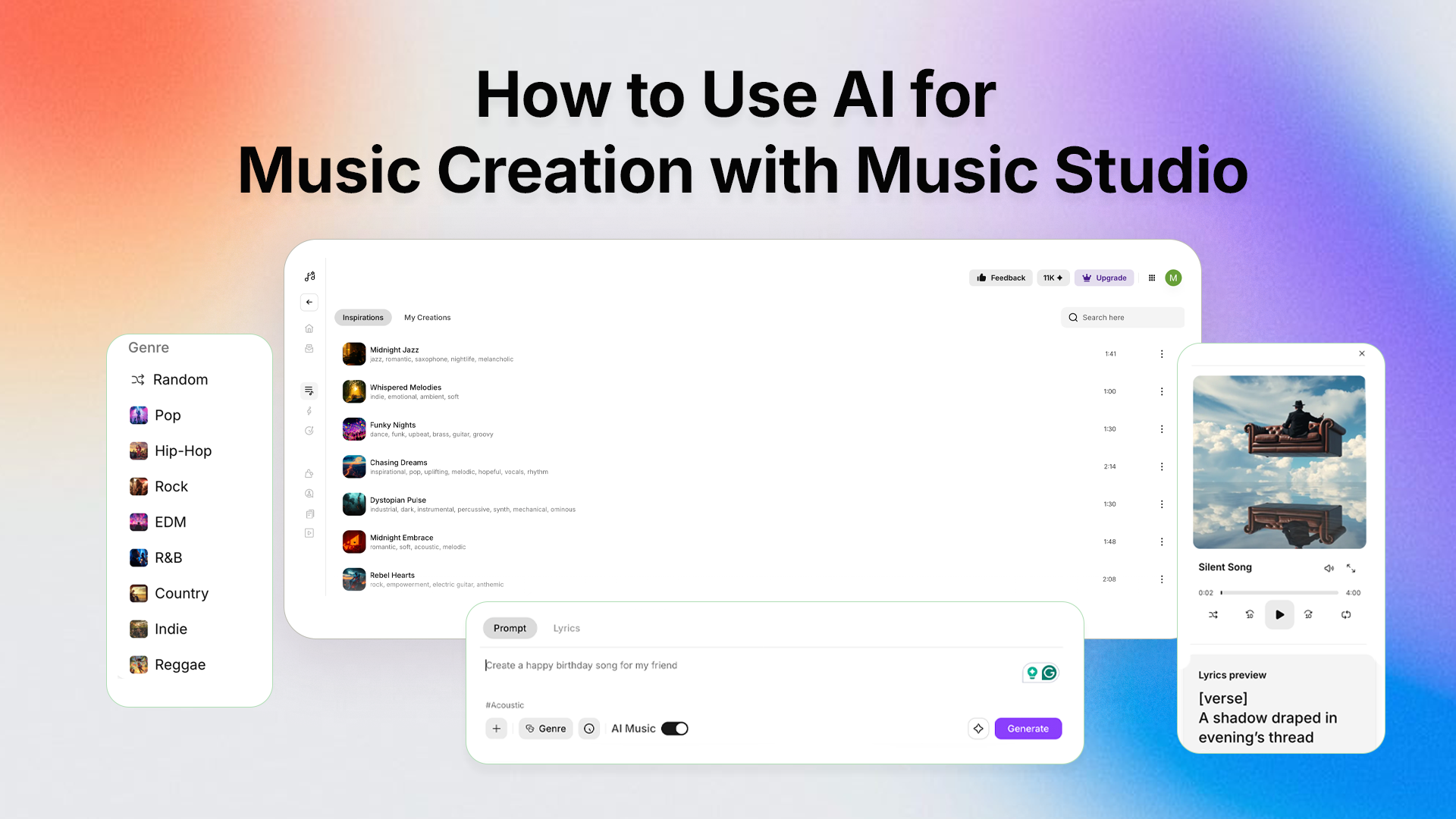

Areeba Imran
Tue Jul 08 2025
7 mins Read
What Is AI Music? Exploring the Future with Music Studio
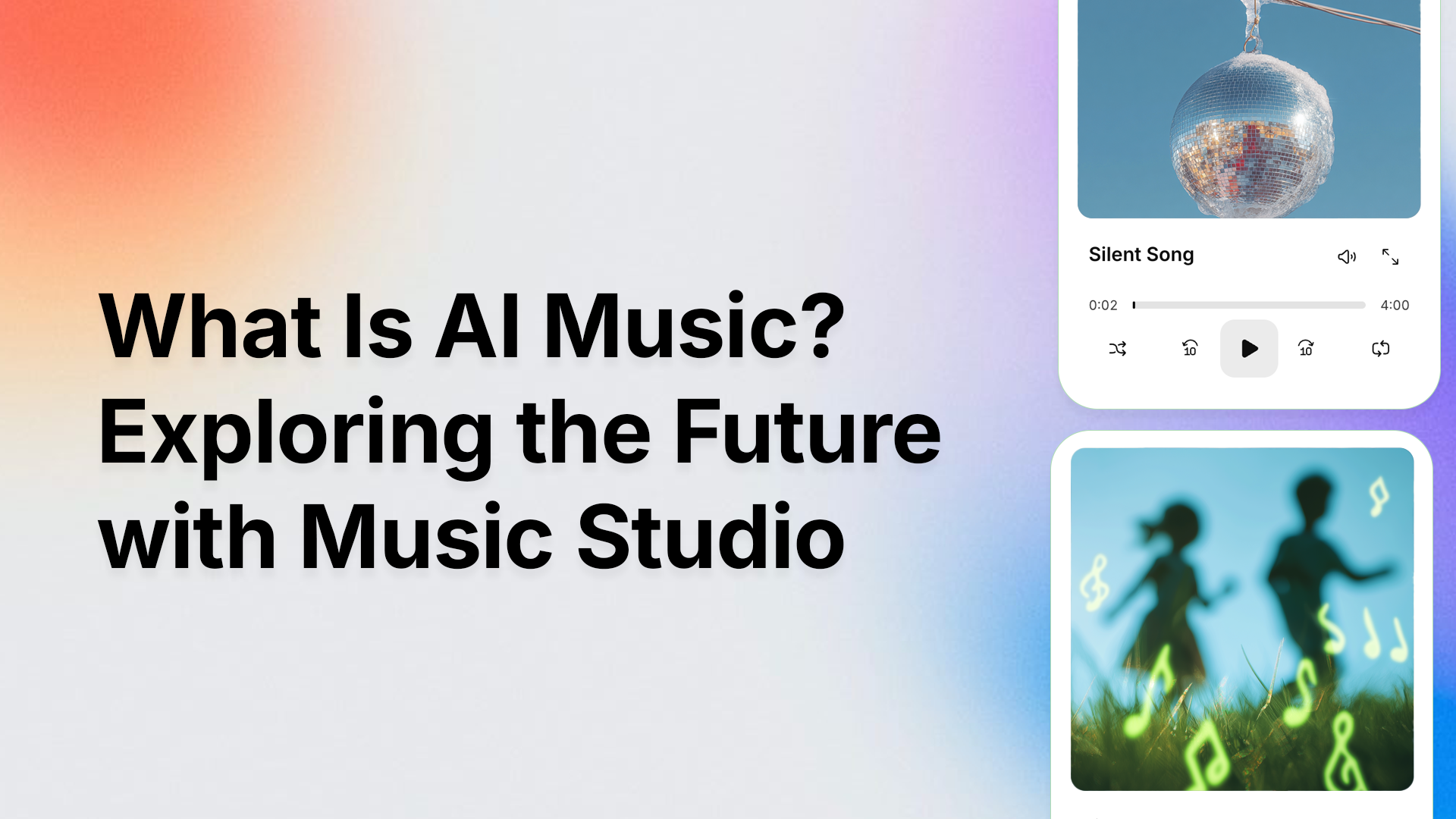 banner.png
banner.png
Music makes the world go around, and now so does AI. What would happen if these two came together, and how would it change everything? Well, you do not have to imagine any of that anymore. Artificial Intelligence is already rewiring the way we write, design, and even make movies, but one of its most fascinating revolutions is happening in Music. What is AI in music? Let’s break it down.
In simple terms, AI music refers to any music that’s composed, produced, or performed with the help of artificial intelligence. From generating melodies and harmonies to writing lyrics and even creating full vocal performances, AI is now an active collaborator in the creative process.
Among the platforms leading this revolution is AI Music Generator, an advanced, all-in-one AI music creation suite designed for both casual users and professional creators.
What Is an AI Song?
An AI song is a track created using AI tools. It may be partially human-guided, such as when a user inputs lyrics or chooses a popular genre, or fully machine-generated. An AI song can include lyrics, melody, harmony, vocals, and even audio mastering, all driven by machine learning models.
Platforms like Music Studio, Suno, and Udio are making this accessible to everyday users, removing the need for a recording studio or technical skills. This means anyone can now create a song from a simple idea or prompt.
What Is AI Generated Music?
AI music is a broad term that includes everything from AI-assisted composing to fully autonomous music generation. It leverages large datasets of music, machine learning models, and audio processing techniques to generate sound based on instructions like genre, emotion, tempo, or even a short description.
When people ask what AI-generated music is, they usually refer to music that has been built from scratch by AI, not sampled or remixed. This kind of music is original, copyright-free, and often tailored to a specific mood, use case, or audience.
Text-to-Song vs Text-to-Music: How AI Turns Words into Sound
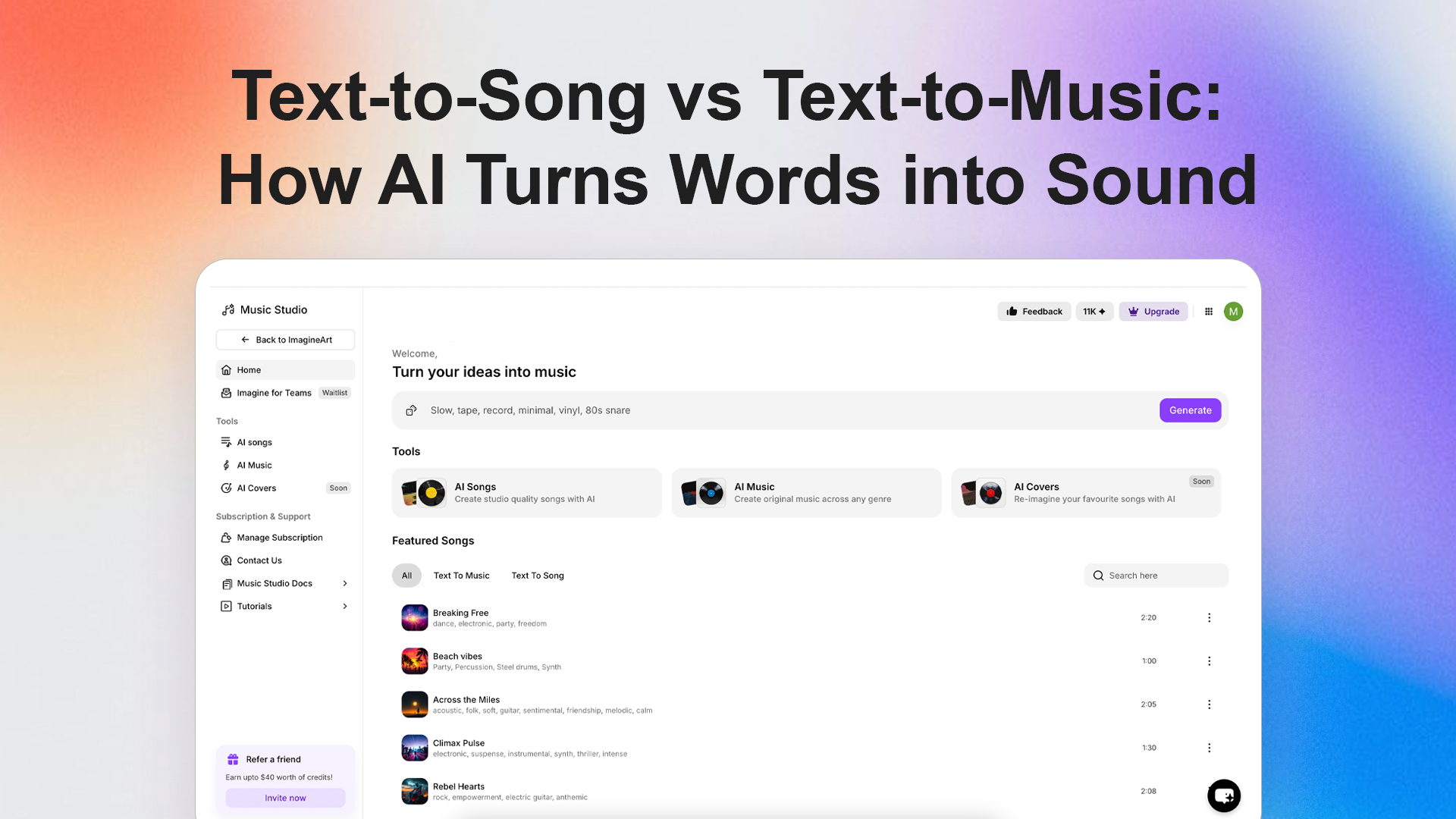 music paage 1.png
One of the most powerful breakthroughs in AI music is the ability to generate music directly from text. This can take two main forms: text-to-music and text-to-song.
music paage 1.png
One of the most powerful breakthroughs in AI music is the ability to generate music directly from text. This can take two main forms: text-to-music and text-to-song.
What Is Text-to-Music?
Text to Music allows users to describe the mood, instruments, genre, and structure of a piece, and the AI generates instrumental music based on that description. For example, you could enter:
“A calming ambient track with soft piano and rain sounds, perfect for meditation.”
The AI will generate an original track matching that vibe, complete with structure, pacing, and audio layering. This is ideal for background music, soundtracks, meditation tracks, or lo-fi beats.
What Is Text-to-Song?
Text to Song, on the other hand, includes not just instrumental music but also AI-generated vocals. You can either provide lyrics or let the AI write them for you. The system then composes a melody, harmonizes it, and overlays vocals from AI singers, available in multiple languages, genders, and styles.
With Music Studio, users can access both text-to-music and text-to-song modes, making it incredibly flexible. Whether you're creating cinematic scores, catchy jingles, a parody song, or full lyrical pop songs, the platform can convert your prompt into a fully-produced track.
Music Studio vs. Udio, Suno, and Riffusion: Where It Stands Out
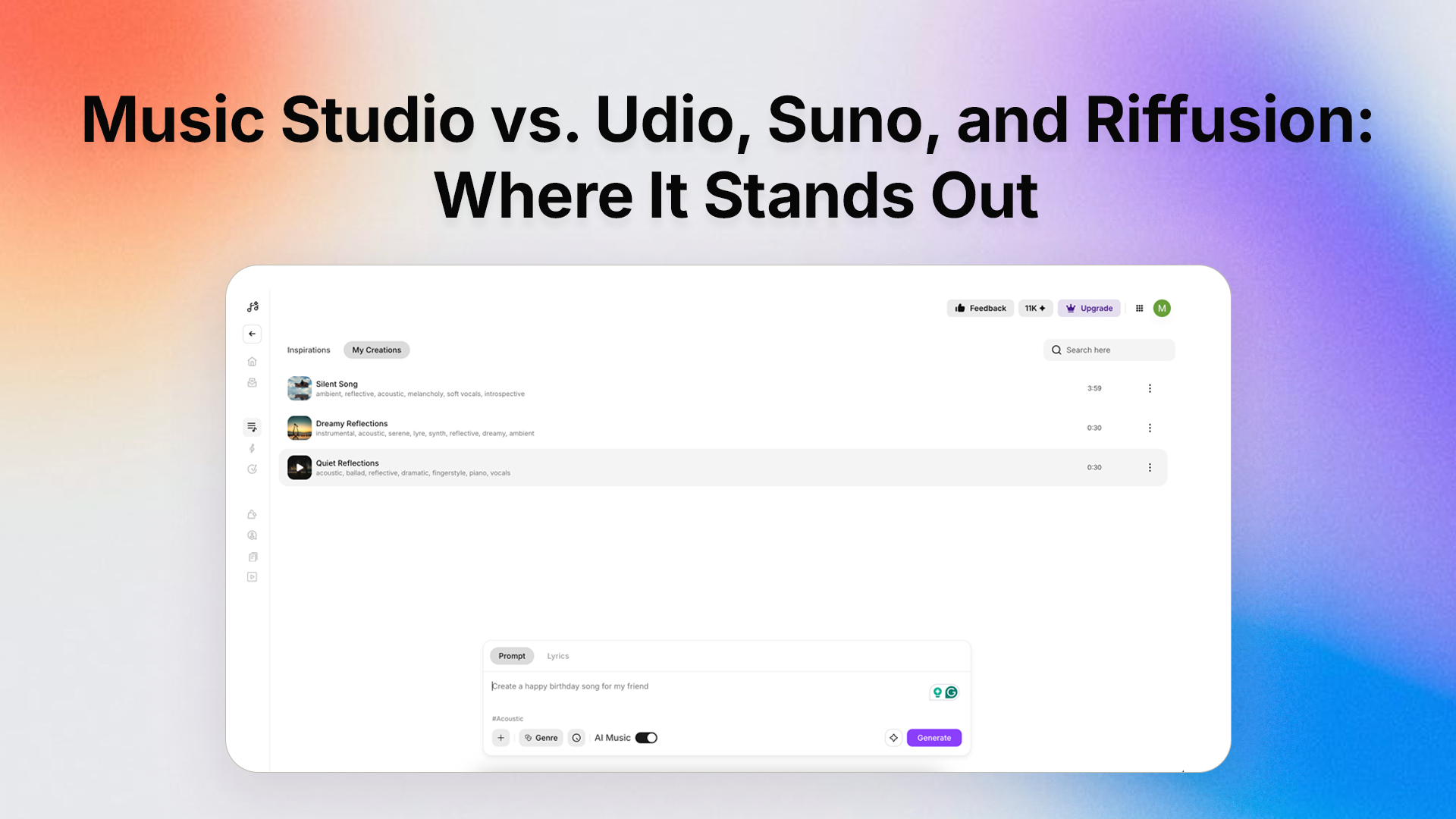 PAGE 2.png
PAGE 2.png
Prompt Control and Flexibility
Music Studio offers advanced prompt inputs where you can describe the mood, emotion, genre, instrumentation, and structure of your music. In contrast, Udio and Suno provide impressive vocal generation, but the depth of customization is often limited to selecting pre-defined genres or styles. You can’t always fine-tune the structure or select specific instruments.
Music Studio allows complete control, even enabling input through humming, MIDI files, or direct lyrics, making it ideal for users who want precision.
Vocal and Language Support
Suno and Udio are known for their lifelike AI vocals, but they're predominantly English-based. However, Music Studio supports other languages, giving global creators more freedom. It also offers multiple male and female voice models, so you can pick one that matches your brand or story.
Export Formats and Production Readiness
Unlike Riffusion, which creates audio from spectrograms and offers limited musicality, it supports professional audio outputs like MP3, and even offers MIDI and PDF sheet music exports. This makes it ideal for classroom instruction, collaborative production, and commercial licensing.
Full Ecosystem Advantage
This isn't just a music tool; it’s part of a larger creative suite. You can pair your AI song with AI-generated video (ImagineShorts), talking-head avatars, or image-based music art, all from one dashboard. Suno, Udio, and Riffusion are standalone tools that lack this seamless integration.
Expanded Use Cases for AI in Music
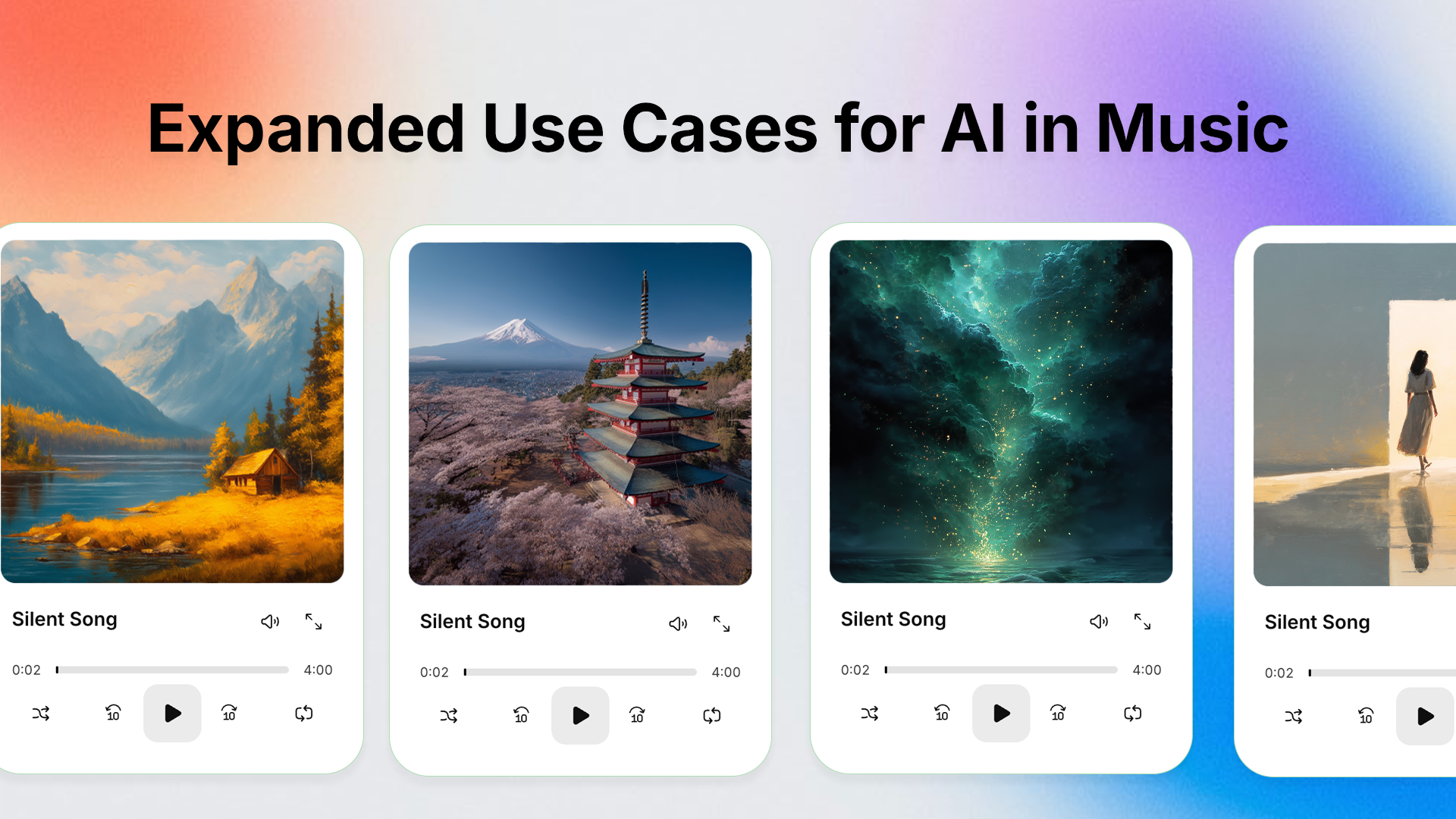 music paage 3.png
music paage 3.png
Here are real-world examples showing how AI in music production is transforming workflows across industries:
1. Meditation & Wellness Industry
“A yoga studio needs relaxing ambient tracks tailored to breathwork sessions and different poses.”
With Music Studio, they generate slow-paced, calming soundscapes in under 2 minutes. They can even export loops to align with session durations. Unlike stock music, the results are uniquely theirs, with no licensing risks or repetition.
2. App Developers
“A developer building a language-learning app wants subtle background music in different languages and moods to match lesson types.”
Music Studio lets them generate low-volume instrumental tracks in multiple moods and languages, aligning perfectly with user experience goals. These custom tunes help with user retention and app polish.
3. Short-Form Content Creators (Reels/TikTok)
“A content creator producing viral videos wants catchy hooks that are copyright-free and can be paired with visuals.”
They describe the vibe (“playful, fast-paced, club beat”), and it delivers a 15-second clip with a vocal tag. It’s instantly usable with ImagineShorts, so there’s no need to sync music manually.
4. Nonprofit Organizations
“A nonprofit making a short awareness film needs an emotional soundtrack and a soft vocal call-to-action at the end in multiple languages.”
It enables them to generate versions in English and Chinese, complete with AI vocals. No need to hire a composer or voice actor, just generate, review, and export.
5. Wedding And Event Planners
“A wedding planner wants to offer couples personalized background music for ceremonies, vows, or slideshows.”
Music Studio makes it easy to create tracks based on themes like “romantic jazz piano” or “dreamy violin duet,” even incorporating the couple’s names into the lyrics if desired.
6. Educational Institutions
“A music teacher wants to show students how chord progressions work by generating examples in real-time.”
Its MIDI output and sheet music export features make it a powerful classroom tool. Teachers can also demonstrate how changing mood or tempo affects the feel of a track.
7. Corporate Teams and Agencies
“A marketing team needs original music for a product explainer and internal corporate video.”
Instead of searching endless stock libraries, they generate four custom tracks using ImagineArt, pick the best one, and edit it directly in their video editor. No licensing fees, no middlemen.
How to Use AI for Music Creation with Music Studio
 music PAGE 4.png
music PAGE 4.png
Here’s what the typical workflow looks like:
- Choose your generation method: Text prompt, MIDI, lyrics, or even humming. -Enter creative parameters: Select genre (e.g., Synthwave), mood (e.g., Hopeful), instruments, tempo, and language. -Generate the track: Within 60–90 seconds, ImagineArt’s Music Studio creates your tune. You can preview and regenerate variations. -Add vocals (optional): Choose from multiple AI voices. You can enter lyrics manually or let the AI write them. -Export your content: Download in MP3, or MIDI. You can also get a sheet music version if needed. -Use it immediately: Pair with a video, use it in a podcast, or upload it directly to social platforms.
The Bigger Picture: Can AI Make Music Better Than Humans?
The question is not whether AI will replace musicians, but how it enables more people to create music. AI in music production unlocks possibilities for those without formal training, expensive gear, or industry connections.
From students to solo developers, from TikTok creators to wedding planners, AI is giving people the power to express themselves through sound. While AI may never match the emotional nuance of human artistry at its peak, it removes barriers and accelerates creative discovery.
Final Thoughts
So, what is AI music? It’s the natural evolution of sound, driven by data, powered by algorithms, and guided by your imagination.
Among today’s leading platforms, ImagineArt’s Music Studio stands out not just for its sound quality, but for the entire ecosystem it offers. With its deep customization, multilingual vocal models, and real-world use cases, it’s the most complete AI music generation solution for creators in 2025.
Whether you’re a content creator, marketer, teacher, or hobbyist, ImagineArt is ready to bring your music ideas to life. Start your music generation journey today!
FAQs

Areeba Imran
Areeba Imran specializes in content marketing for GenAI and SaaS companies, helping them grow with strong writing and strategy.